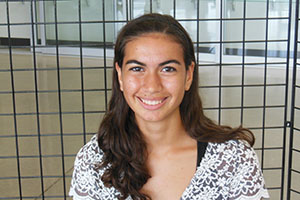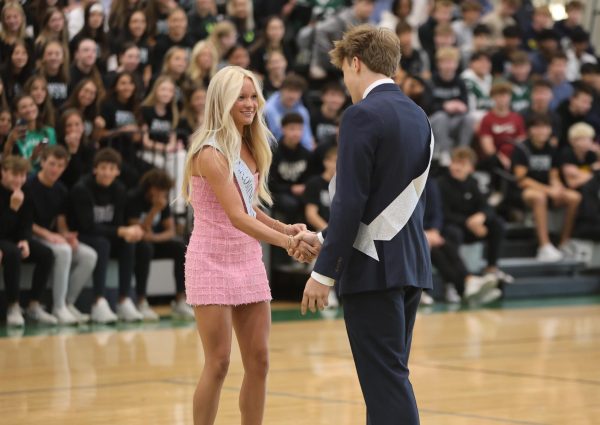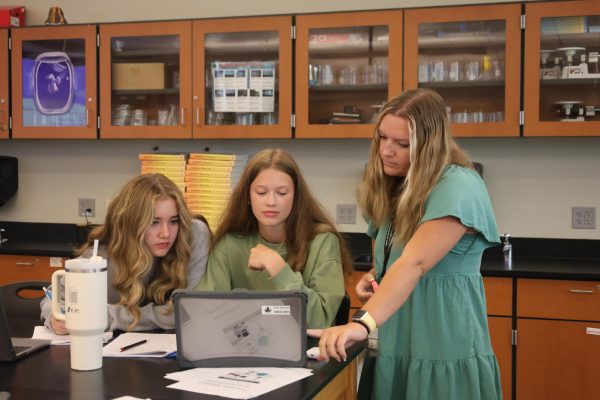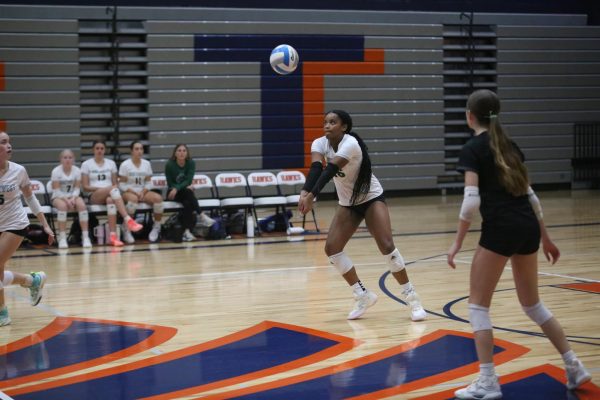How the school allows religious freedom without promoting religious beliefs
Last year, sophomore Alexa Kathol chose a book about creationism to read for biology class. Although the class learned only about evolution, Kathol said “telling kids that they’re nothing more than an educated fish seems a little dehumanizing.”
While she was allowed to do so, she said that her peers “thought [she] was crazy and they probably thought [she] was just trying to stir up conflict,” and her teachers seemed “very shocked” with her choice. When the class was presenting in small groups, Kathol said her teachers “went around to every group and listened in” except for hers.
“Nothing was necessarily uncomfortable,” she said. “It was more of just an overwhelming feeling of sadness, because I had this realization that kids actually believe the things that teachers are telling them about evolution, and it’s sad to know that I know the truth about the detail and love and passion that went into creating humans.”
Creationism is commonly brought up in the conflict of finding the line between religious freedom and religious promotion in a public school. The first amendment of the U.S. Constitution states, “Congress shall make no law respecting the establishment of religion or prohibiting the free exercise thereof.”
The problem lies in the following clauses: while the Establishment Clause “requires neutrality from government and prohibits public school advancement of religion,” the Free Exercise Clause “prohibits schools from interfering with religious expression.”
“I think people should be able to express who they are,” sophomore Michael Taylor said. “I don’t think we should say absolutely no religion, because I know that’s a big part of people’s lives, and it’s really not fair just to cut it out completely.”
In September of 2013, a nonprofit group called Citizens for Objective Public Education filed a lawsuit to block the Department of Education from adopting the Next Generation Science Standards that would teach evolution and climate change in science classes. According to the Huffington Post, the lawsuit claimed that the standards would promote atheism and therefore violate the separation of the church and state.
But the lawsuit was dismissed, and the Next Generation Science Standards stayed in place. According to the National Academy of Sciences, “creationism, intelligent design, and other claims of supernatural intervention in the origin of life or of species are not science because they are not testable by the methods of science.” Creationism is still not allowed to be taught in the classroom.
Kathol, however, did have the right to write about creationism. Students have the legal right to choose religious themes for self-directed assignments. In the past, students have also written about evolution versus creationism for argumentative papers. But while writing about these topics is allowed, English Language Arts teacher Shauna Rinearson said it is difficult for students to remain objective in these papers.
“From a rhetorical standpoint, the greatest challenge that a student faces in writing about any controversial topic is the strong possibility of relying on emotion rather than logic and turning what should be a reasoned argument, supported through effective evidence, into a persuasive paper supported by emotional appeal and personal opinion,” Rinearson said. “When we choose to write about issues such as evolution versus creationism, it may be very personally dear to our hearts, and perhaps we have exceptionally strong convictions about those issues.”
In the case of writing about religion for school assignments, the problem is not necessarily related to the fact that the subject matter was religious. Similarly, sometimes seemingly religious items are used for secular educational purposes.
Assistant Principal Todd Dain said religion is a “valid part of school curriculum” because it is a part of culture — it is talked about in social studies, English and world language classes. For example, quotes from the Bible or other religious texts are allowed on the walls of classrooms if they are treated as literature and promote positive, universally applicable ideas.
The school’s policy is that religious symbols can be on display in classrooms where they are relevant, such as a world history class, as long as all religions are equally represented. Sophomore Jacob Ginsberg believes that while teachers should not devote their entire classrooms to a religious belief, it should be OK to “just have a cross or something in a corner or on a wall” or for students to “have some sort of satanism thing on their desk.”
“People should definitely have freedom of religion because that’s what keeps people different, and that’s what makes things interesting,” Ginsberg said. “I just think people should be more accepting and less threatening toward people who are different.”
The school, however, is not allowed to promote any one particular belief. For this reason, students aren’t allowed to pass out religious items because of the chance that some students who want them might not get them or students who do not want them might receive them. And if teachers want to share their own religious beliefs with students, they can only do so outside the classroom. They are required to make it clear that it is their own perspective as individuals and not as teachers.
“We’ve never asked a teacher to lie, and I think that honesty and that transparency are very important,” Dain said. “But the teacher has to separate their role as the teacher and as a role model and separate their duty as someone with influence over students.”
But freedom of religion also allows students to express themselves. Kathol said players on the girls basketball team write Bible verses on their arms before games.
“It’s covered under our First Amendment rights — freedom of speech and freedom of religion — so I feel like [it] is important that schools and people in the school recognize that America is different; America was founded on the principle that people are allowed to do this,” Kathol said. “For me, Christianity isn’t just a religion; it’s a relationship and a lifestyle.”
Lastly, religious freedom provides students with more chances to learn about different cultures and ways of thinking outside of the classroom. Even though Taylor is no longer affiliated with a religion, he said “faith plays a huge role in some people” and he believes students should be able to talk about religion at school openly.
“I think you should be able to be who you want to be in school,” Taylor said. “I think we all are really diverse, and when you’re not tolerant and you force somebody to conceal part of who they are, not only do you not get to really experience who that person is, you miss out on the opportunity to learn.”
Myth vs. Fact
Myth: School meetings can’t be held at religious buildings and religious groups can’t meet at schools.
Fact: All outside groups have to have an equal opportunity to access school facilities, so the PAC or fixed forum can be rented out to religious groups. School meetings can be held at church facilities to accomodate for the size of the group.
Myth: Students are not allowed to pray at school or school-related activities and events.
Fact: According to the American Civil Liberties Union, “children are free to pray in public schools either as individuals or in groups.” However, coaches can still designate certain times before a game as time for the team, and therefore ask students not to pray or do anything else on their own.
Myth: Only certain religious clubs are allowed to hang posters in the school.
Fact: All school clubs and groups, including FCA and JSU, have equal access to bulletin boards, hanging posters and announcements, as long as the messages are open to all and relflect that everyone is welcome.
Myth: Teachers are never allowed to talk about personal religious beliefs with students.
Fact: While faculty members cannot pray with students or lead religious discussions, they are allowed to share their religious perspectives with students, as long as it is done outside the classroom.

2014 marks Ananda Bhatia's third year in newspaper and first year as editor-in-chief. She is incredibly excited to work with such a talented and hard-working...










